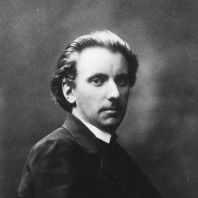Rued Langgaard
composer
None other than György Ligeti was impressed by Rued Langgaard’s music. In 1968, Ligeti and the Danish composer Per Nørgård were members of a jury whose task was to judge new works. Nørgård had secretly smuggled Langgaard’s Sfærernes Musik (The Music of the Spheres), composed in 1916–18, into the selection – in whose score Ligeti found some of the revolutionary compositional devices that he himself had used in his soundscape composition Atmosphères. Langgaard, however, had developed them 40 years before Ligeti.
Rued Langgaard was born in Copenhagen on 28 July 1893 and received his first musical training from his parents: his father Siegfried, a former pupil of Liszt, taught for many years at the Royal Danish Academy of Music in Copenhagen after his brief career as a pianist and composer; Langgaard’s mother Emma was a pianist. At the age of 11, the budding musician made his debut with organ improvisations in Copenhagen’s Marble Church, and when he was 14, his first large-scale composition Musae triumphantes for vocal soloists, male choir and orchestra was performed in Copenhagen’s Odd Fellow Palace. Until 1923, Langgaard, whose musical training in violin, organ and music theory had been provided by a number of private teachers, performed as an organist and pianist with his own works and was also occasionally active as a conductor. He had largely taught himself the craft of composition – during extended study visits to Berlin, where he became acquainted with conductors such as Arthur Nikisch and Max Fiedler, who successfully premiered Langgaard’s First Symphony Klippepastoraler (Cliffside Pastorals) with the Berliner Philharmoniker in April 1913. Although further works by Langgaard were performed to delighted audiences in Berlin, Karlsruhe, Essen, Bochum and Vienna after the First World War, they did not enjoy success in Denmark. For many years, Langgaard’s efforts to find an organist position in his home country were also in vain. It was not until 1940, at the age of 47, that he managed to get a job as organist at Ribe Cathedral in Jutland – far away from the Danish music centre of Copenhagen. Langgaard’s extensive oeuvre of 431 works was almost completely forgotten after his early death in 1952 and was only rediscovered in the 1960s. Despite their late Romantic idiom, Langgaard’s works foreshadow modern techniques such as collage, soundscapes and minimalism.